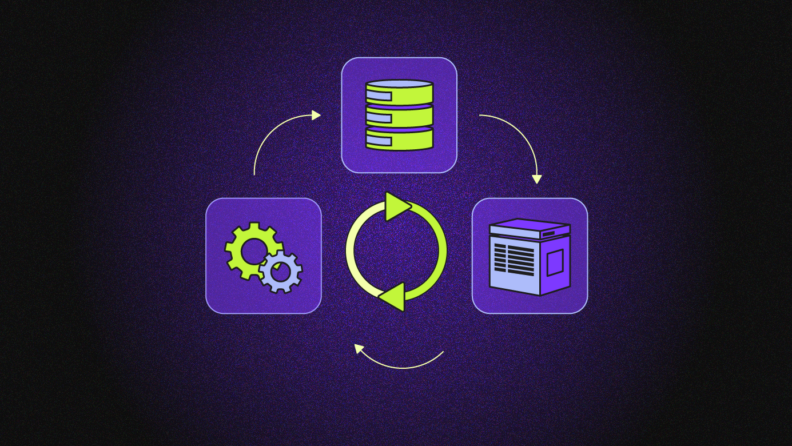ETL pipelines are a set of processes used to move data from one or more sources to a database or data warehouse. ETL stands for “extract, transform, and load,” describing the processes required to do this. Knowing how to build efficient ETL pipelines can greatly improve your business intelligence efforts and simplify data management.
ETL pipelines are often used in data science because of their utility for data cleansing and optimizing data sets. However, it’s useful in business settings too, especially in the modern world of big data.
Today, many tools can streamline data management workflows, and, as we’ll discuss in this guide, these tools form a crucial part of modern ETL pipelines.
What Are ETL Pipelines?
ETL stands for Extract, Transform, Load. Let’s consider each step of the process in turn:
- Extract: This process pulls data from an API, extracting it from a database or reading it from a dump (such as an XML or JSON file). Depending on the number of data sources you’d like to extract data from, setting up connectors and parsing the data could be a complex process. Data management tools can often help with converting data from multiple sources to a single consistent format.
- Transform: Once the data has been obtained, the next step is to sanitize it, remove duplicates, standardize data (for example, ensuring all dates follow the same format), restructure it to match the schema of the target database, and make sure all fields are mapped correctly. This can be a time-consuming process and something that may need to be reviewed regularly if any of the data sources change the way they supply data.
- Load: Finally, the transformed data can be imported into the target database, data warehouse, or platform. The exact process for completing this upload may vary depending on the target platform. The initial load may take some time as it involves uploading a lot of data to populate the database. In the future, updates can be managed through incremental data changes, but occasional full refreshes may be performed to ensure data integrity. Many data engineers automate the update process and schedule it for off-peak periods when source systems will be seeing minimal traffic.
Planning and Designing Effective ETL Pipelines
The sheer volume of data handled by ETL pipelines makes their implementation a significant undertaking. To ensure the process is a success, data engineers must have a good understanding of the data they’ll be processing and the goals of those working with the data.
Key Considerations Before Building an ETL Pipeline
There are a few key challenges when dealing with big data:
- Data volume: A key element is the amount of data collected and the costs associated with storing (and transmitting) that data. In some cases, organizations have no control over the volume of data provided by third parties when they request an export. However, you can decide which data to keep and what’s redundant.
- Data variety: You must also consider the types and formats of data you’re working with and whether that data is structured or unstructured. Data engineers can address this challenge by using transformation and standardization tools to convert all data into a common format.
- Data velocity: Describes the speed and frequency with which data is being collected. A high data velocity can cause problems when attempting to automate your pipelines, especially if you’re looking for the most accurate data from all sources for data-driven decision-making.
Once you’ve addressed those issues, you can consider the purpose of consolidating the data and the end goals of data analysis. Those goals may influence database design decisions.
Choosing the Right ETL Tools and Technologies
It's possible to write your own ETL tools from scratch — and some smaller organizations do opt to go down this path, assuming it will be cheaper and easier than working with off-the-shelf solutions.
While this can be true when importing only from one or two data sources that rarely change their export formats, it’s seldom the best route. ETL tools offer more advanced data processing, cleansing, and profiling solutions, advanced automation and batch processing features, and significant benefits in terms of reliability and ease of use.
When choosing an ETL solution, consider the following:
- Supported data formats (SQL, XML, JSON, CSV files, etc.)
- API integrations
- The availability of real-time streaming for ingesting data (Apache Kafka is a popular solution for this)
- Whether the solution is cloud-native (Tools that support the easy loading of data into Amazon AWS or Google Cloud data lakes can be invaluable for organizations requiring flexibility and agility with their data warehousing)
- Support response times
- Pricing
Many open-source ETL solutions are available, some of which offer free community editions and fund their development by charging for technical support. If your organization has a limited budget for its ETL implementation, choosing a widely used open-source solution could save you a lot of money.
Design Principles for Scalable and Maintainable ETL Pipelines
When designing an ETL pipeline, it’s crucial to not only consider the data sources you’re currently working with but also how your needs might evolve in the future. Some things to consider include:
- Modular design: Break down the system into data extraction, data cleaning, and the loading process. Consider the various data formats you may need to work with and create a modular system, so it’s easy to change different parts of the system without breaking the whole pipeline.
- Error handling: Design your system so it fails gracefully and with a clear error message if it encounters data it doesn’t understand or is in an incorrect format. It’s better to have a system skip records it can’t handle and supply a warning message than to have it fail completely, causing delays in the loading process or, worse, loading incorrect data and corrupting the primary data store.
- Clear and complete documentation: Clear documentation is essential. Keep in mind that not all of your team are data scientists. Many of the people interacting with the data could be team leaders or department heads who simply want an easy way to access real-time data from several different sources at once. Have a set of documentation for them and a set for the developers that explains the pipeline in more detail. Outline essential design principles, such as modularity, error handling, and documentation practices.
ETL Pipeline vs Data Pipeline
ETL and data pipelines are similar processes but with slightly different use cases. An ETL pipeline covers the extraction of data from one or more sources, transforming that data, and then loading it.
In contrast, a data pipeline can include some or all of the above steps but doesn't end with the loading process. Once the data has been loaded, it can be used in other processes and workflows, for example, for a visualization system or to conditionally trigger an action in an automation system.
Key Benefits of ETL Pipelines
ETL pipelines can be incredibly useful for fueling analytics and business intelligence systems. Because they unify data from several sources, for example, bringing together data from social media, CRM systems, ERP tools, and other databases, they make it easier to get accurate business insights.
The ETL process involves optimization, validation, and cleaning of data, helping ensure the information that makes it into the database is as accurate and current as possible.
The reliability of your ETL pipelines depends on the tools you use. A pipeline could be as simple as a few Python scripts or something more robust that uses Snowflake, Kafka, and other modern tools. Today, the tools available to process data and build an ETL pipeline are quite mature. Easy-to-use GUIs and active user communities allow even novice data scientists to get started with ETL pipelines.
Disadvantages of ETL Pipelines
While the toolchains for building ETL pipelines are mature and cloud data warehouses are far more affordable today than they were a few years ago, some challenges still exist when it comes to building data pipelines:
- Dealing with structured, unstructured, and semi-structured data can be difficult.
- Data storage costs can be prohibitive for some organizations.
- Real-time data streaming can be both complex and resource-intensive.
- Mapping databases and setting up integrations isn't a one-time job. Data providers may change their export formats or database schemas, requiring you to alter your pipeline.
ETL Pipeline Implementation
Consider the following workflow for implementing an ETL pipeline:
- Create reference data, so you have something to work with when performing data transformations.
- Build connectors for the data sources you’d like to work with, such as:
- API interfaces for social media platforms
- Scrapers for web pages (if the TOS permits this)
- Parsers for XML/CSV/JSON files
- Database connectors for your own on-premises systems
- Define rules for validating the data.
- Apply transformations to clean and standardize the data and remove duplicates.
- Upload the data to a staging system.
- Load the data from staging to the data warehouse.
Some of the above steps are optional. For example, reference data isn't required, but it's helpful because it makes defining rules for testing the data and performing transformations easier. In addition, it’s not necessary to stage data before loading it. However, it’s a best practice to do so because it’s easier to roll back the staging layer if something goes wrong, and that layer can be used for audit reports and other compliance requirements.
ETL Pipeline Tools to Test Out
Many available ETL tools can streamline data processing, aggregation, cleansing, and loading onto your target system. The ETL software market is valued at around $3.1 billion and is projected to reach $10.3 billion by 2030, so there’s no shortage of options.
Some popular tools include:
- Informatica Power Center: A versatile solution with cloud support, including low- and no-code tools for ETL pipelines
- Apache Airflow: A powerful open-source platform with command line and GUI interface options
- IBM Infosphere Datastage: A fast and powerful solution with load balancing and parallelization features
There are many other options, including solutions from Oracle and Microsoft. When selecting an ETL solution, consider your budget and existing ecosystem, as staying with vendors you already know well could be a reliable and cost-effective choice.
Takeaways
ETL pipelines are a crucial part of data management for modern businesses that process significant data volumes. Implementing an ETL pipeline can help improve your organization’s decision-making and give your business a competitive edge.
However, dealing with raw data from multiple sources can be challenging, and tech leaders must emphasize the importance of careful planning and documentation throughout the process and abide by data protection and privacy regulations.
To learn more about ETL pipelines, data processing and other big data challenges and innovations, subscribe to the CTO Club Newsletter.




